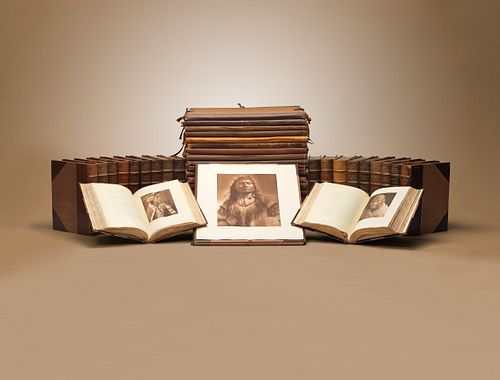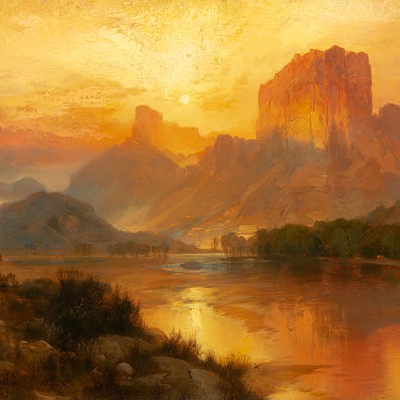Edward S. Curtis (1868-1952); The North American Indian, Portfolios 1-20; and Vols. 1-20; Stickley Brothers (early 20th cen) American Oak Book Cabinet
Lot 152
About Seller
Coeur d'Alene Art Auction
11944 North Tracey Road
Hayden, ID 83835
United States
Coeur d’Alene Art Auction specializes in the finest classical Western and American Art representing past masters and outstanding contemporary artists. The auction principals have over 100 years of combined experience in selling fine art and have netted their clients over $325 million in the last fif...Read more
Estimate:
$1,500,000 - $2,500,000
Absentee vs Live bid
Two ways to bid:
- Leave a max absentee bid and the platform will bid on your behalf up to your maximum bid during the live auction.
- Bid live during the auction and your bids will be submitted real-time to the auctioneer.
Bid Increments
| Price | Bid Increment |
|---|---|
| $0 | $250 |
| $5,000 | $500 |
| $10,000 | $1,000 |
| $20,000 | $2,500 |
| $50,000 | $5,000 |
| $100,000 | $10,000 |
| $200,000 | $25,000 |
| $500,000 | $50,000 |
| $1,000,000 | $100,000 |
About Auction
By Coeur d'Alene Art Auction
Jul 25, 2020
Set Reminder
2020-07-25 15:00:00
2020-07-25 15:00:00
America/New_York
Bidsquare
Bidsquare : Fine Western & American Art
https://www.bidsquare.com/auctions/coeur-dalene/fine-western-american-art-5263
The 2020 Coeur d'Alene Art Auction to be held July 25 in Reno, Nevada, will feature 264 selections of unparalleled quality in Western paintings and sculpture from historical and contemporary artists such as Charles M. Russell, Henry Farny, Thomas Moran, Edward S. Curtis, Carl Rungius, and more. Coeur d'Alene Art Auction info@cdaartauction.com
The 2020 Coeur d'Alene Art Auction to be held July 25 in Reno, Nevada, will feature 264 selections of unparalleled quality in Western paintings and sculpture from historical and contemporary artists such as Charles M. Russell, Henry Farny, Thomas Moran, Edward S. Curtis, Carl Rungius, and more. Coeur d'Alene Art Auction info@cdaartauction.com
- Lot Description
Edward S. Curtis (1868-1952)
The North American Indian, Portfolios 1-20; and Volumes 1-20
Large-format photogravures, published as Portfolios 1-20, The North American Indian, Being a Series of Volumes Picturing and Describing the Indians of the United States and Alaska, Seattle, WA; New York; and Cambridge, MA: University Press, 1907-1930. Each plate printed on Van Gelder Holland with letterpress copyright credit, title, plate numbers and John Andrew & Son printer’s credit (in the margin). Each approximately 15.5 x 11in. (39.3 x 28cm.) or the reverse. Each in original half-morocco folding case with gilt-impressed portfolio number. Accompanied by Cambridge, MA: University Press, 1907-1910 (Volumes 1-5); Norwood, MA: Plimpton Press, 1911-1930 (Volumes 6-20). 20 bound text volumes, containing a total of approx. 1,506 small-format photogravures, edited by Frederick Webb Hodge, with foreword by Theodore Roosevelt, signed in ink. Each volume numbered ‘83’ in ink (on the colophon) from the realized edition of 272. Bound in the original half-brown morocco gilt by H. Blackwell.
signed and dated Edward S. Curtis 1907 lower right (vol 1, p xvii)
signed Theodore Roosevelt lower right (foreword)
Stickley Brothers (early 20th century)
American Oak Book Cabinet from the personal library of Edward S. Curtis
55.75 inches high, 47.375 inches wide, and 19.75 inches deep
According to Western American art historian Dr. Larry Len Peterson, “In 1907 The New York Herald dubbed a planned photographic book series by Edward S. Curtis as the, ‘Most gigantic undertaking in the making of books since the King James edition of the Bible.’
“In the summer of 1900, George Bird Grinnell invited Curtis to witness firsthand the Blackfeet Sun Dance outside Browning, Montana. ‘Their humanity has been forgotten,’ Grinnell said explaining the stereotypes of either virtuous savage or victim who turned to vices. Inspired, Curtis wrote, ‘I don’t know how many tribes there are west of the Missouri...maybe a hundred. But I want to make them live forever—in sort of history photographs.’
“At the suggestion of Theodore Roosevelt, Curtis solicited John Pierpont Morgan who promised to loan him $15,000 a year for five years. In return, Curtis would author twenty volumes of text, each illustrated with approximately seventy-five small prints and accompanied by a portfolio of thirty-five large photogravures. The first two volumes were published in 1907. Grinnell would write, ‘The results which Curtis gets with his camera stirs one as one is stirred by a great painting.’
“By the end of 1924, Curtis had completed a total of fourteen volumes. The final volume of The North American Indian was printed in 1930, by which time the Morgan family had contributed almost $400,000 ($10 million in today’s dollars)—one-quarter of the total cost of the entire project. In the end, it required thirty years and over 400,000 photographs by Curtis to complete his mission. Each of the twenty-volume sets contained 2,234 original photographic reproductions, 2.5 million words of enlightening anthropologic text by Curtis, and numerous transcriptions of language and music. 272 sets were eventually published.
“Curtis died on October 19, 1952 in Los Angeles—poor and unremembered. It is hard to image that there was any artist of the American West who was more dedicated than him. His hard work is still appreciated today with more books written about him by far than any other Western American photographer.”
PROVENANCE
Parker Corning, Albany, NY
Paul T. Seashore, CA, gifted to
Texas Memorial Museum, The University of Texas, Austin, TX 1954
[Christie’s, New York, NY 2005]
Private Collection, NY 2005 - Buyer's Premium



 EUR
EUR CAD
CAD AUD
AUD GBP
GBP MXN
MXN HKD
HKD CNY
CNY MYR
MYR SEK
SEK SGD
SGD CHF
CHF THB
THB
























